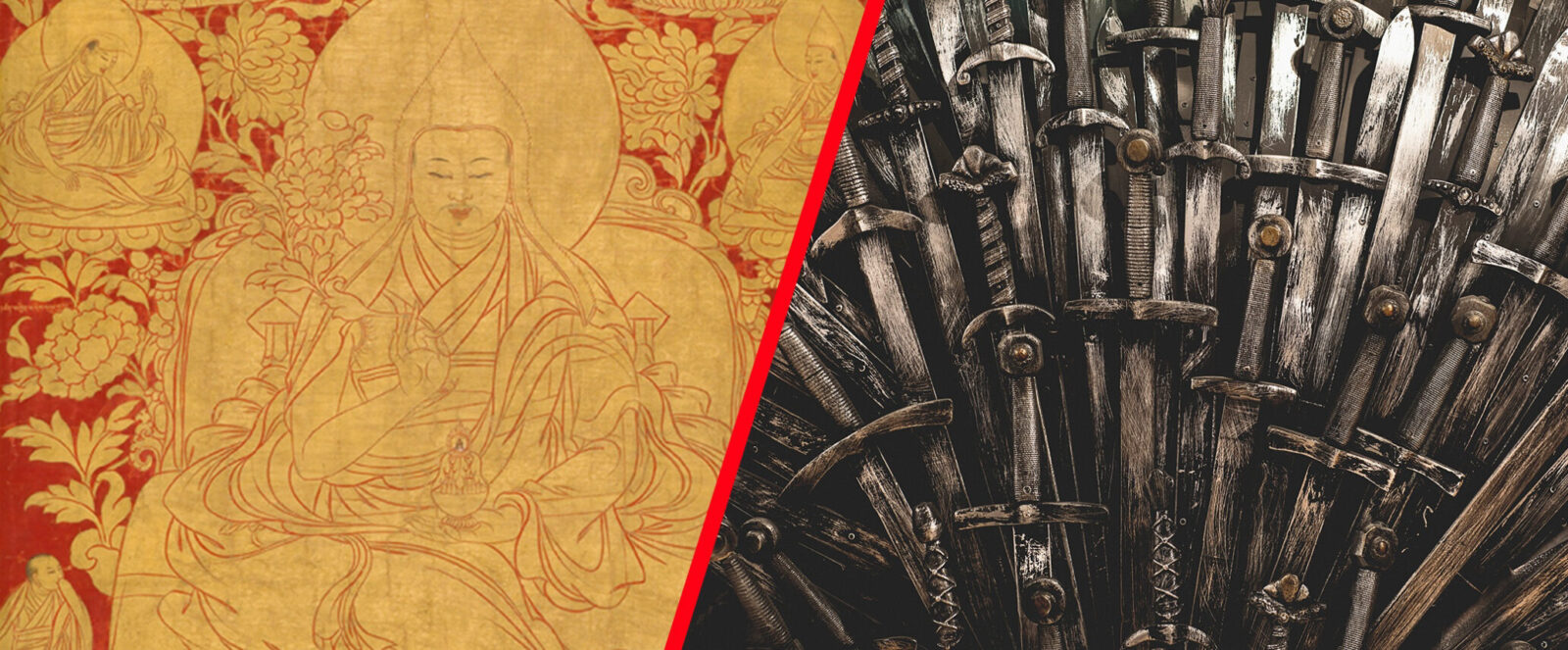


This post is part of a four-part series exploring the connections between Game of Thrones and the dynamics of power in the world of Tibetan Buddhism. Warning: spoilers from seasons one through seven lie ahead.
The ability to predict the future is a defining characteristic of a prophet, and examples of such forecasting abound in fiction and history alike. Greek mythology remembers Cassandra whose warnings of doom for Troy went unheeded, and some believe the French astrologer and physician Nostradamus predicted every major world event since the fifteenth century in his vast tome of obscure prophecies.
George R. R. Martin’s A Song of Ice and Fire novels and the Game of Thrones television series on which it is based employ prophecy as a means of plot development and character motivation. As in other fictional works, prophecies also structure the audience’s expectations and foreshadow plot twists.
Prophecy has also shaped the real-life history of Tibetan Buddhism, providing the basis for rulers to hold and maintain power. Religious prophets not only foretell the future, but in so doing address the current challenges of society and proclaim new ways to live. We continue to be fascinated with prophets and prophecies, not only in an effort to predict the unpredictable but also to gain a measure of control.
Prophecy plays a key role in Game of Thrones, and it fuels not only the characters’ motivations but also some crazy fan theories. Yet Martin himself encourages skepticism about the prophecies in his work, explaining that in literature and in life prophecies may not come true, or they may come true in unexpected ways. The characters in Game of Thrones don’t agree on how to interpret the many signs and visions, so the real influence of a prophecy is how they react to it.
For instance, the young Cersei Lannister consulted a woods witch who made several predictions about her future, including that after becoming queen, a younger and more beautiful queen will cast her down. This queen’s identity remains open to debate, but the prophecy is a strong motivation for Cersei’s actions against rivals.
Some characters have special powers of prophecy, including Melisandre, who sees the rise and fall of kings in her fires but cannot always interpret the visions. Is the messianic Prince That Was Promised Stannis, Jon Snow, or Danaerys?
Those with the strongest prophetic powers are the greenseers who can see the past, present, and future in dreams. Bran Stark has recurring visions of a three-eyed raven, who is actually a greenseer living in a tree beyond the Wall. Under his tutelage, Bran gains mastery of his power of prophecy and prepares to use this insight in the coming battle with the White Walkers.
From the beginning of Buddhism, prophecy has shaped the life narratives of its luminaries. According to stories of the Buddha’s life, his father received a prophecy that his son would become a buddha with insight into the dharma or a world-conquering monarch. The Buddha himself prophesied his own enlightenment after he was born.
Tibetan Buddhists believe that seers like the tantric master Padmasambhava buried treasure texts to be discovered in moments of need in the future. Treasure revealers such as Tangtong Gyelpo used their own prophetic powers to find these texts and decode their contents.
Prophecy also connects Tibet’s rulers to the past and grants them legitimacy. The formative patron-priest relationship between the Mongol emperor Kublai Khan and Lama Pakpa became the model for the karmic connections claimed by later Tibetan rulers and foreign emperors.
Predictions and omens play a role in finding the next Dalai Lama or other spiritually powerful reincarnations. Many signs are ambiguous, leading to disputes over incarnations, which sometimes open the door to politically motivated selections. For this reason, the Dalai Lamas have commissioned artworks of their past incarnations in order to validate their lineage. Some examples are on view in the Rubin’s exhibition Faith and Empire: Art and Politics in Tibetan Buddhism, including the painting below.

The Fifth Dalai Lama, Ngawang Lobzang Gyatso (1617-1682) with Previous Incarnations; Central Tibet; 18th century; Pigments on cloth; Rubin Museum of Himalayan Art, gift of the Shelley and Donald Rubin Foundation; F1996.29.3
After this lineage took control of Tibet in 1642, Tibetan state power depended on the prophecies of oracles like Nechung, and the Dalai Lama often consulted such oracles before making important decisions. As Chinese armies approached Lhasa in 1950, the Nechung oracle warned of “trouble ahead” and told the Dalai Lama to take power.
We seek prophecy because the future is inherently uncertain and risky, and knowledge of it would give us power. Whether we want to know the ending of Game of Thrones or the outcome of our own lives, we are not content to simply wait and see. Tibetan Buddhists believe in the ability of prophecy, not only to foresee what is to come but also to guide us to be in the present.

William Dewey was formerly a curatorial fellow at the Rubin Museum. He completed a PhD in Tibetan Buddhism from the University of California, Santa Barbara, and spent a year teaching at the Rangjung Yeshe Institute in Kathmandu.
Get the latest news and stories from the Rubin, plus occasional information on how to support our work.